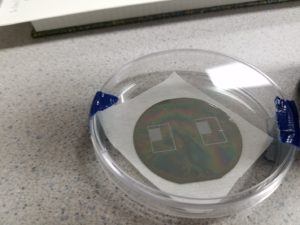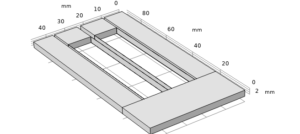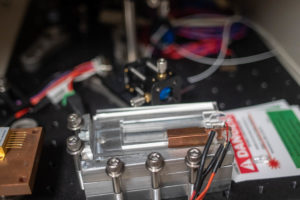New Sensor Fabrication

LASSO is designing compact optomechanical sensors for use in several projects, such as the space geodesy and inertial sensing initiatives. These types of sensors can be costly and as such our group is currently working to fabricate monolithic mechanical sensors using the facilities available at James C. Wyant College of Optical Sciences. We are in the early stages of the fabrication process and are working to optimize the process with low loss materials. Sensor fabrication is being tested using Si wafers, maskless laser lithography, and Bosch etching. These sensors will be used in future accelerometer tests and may be expanded to the LIGO project.
Researchers Involved:
Sensor Modeling
When designing new sensors, we need to predict the acceleration sensitivity that we can achieve for a given topology and resonant frequency. This sensitivity is limited by both the readout noise and the self-noise of the resonator. The self-noise, sometimes called the thermal noise, represents the limiting sensitivity that can be achieved regardless of how good the readout is, and is highly dependent on the topology and material of the resonator. Therefore, it is imperative to design resonators that minimize the thermal noise through optimization of the resonator dimensions and careful selection of the material. An example of such a resonator is shown to the left.

A COMSOL rendering of a 10Hz resonator with two 0.95 gram test masses, each supported by two 3mm x 60mm x 0.1mm flexures.

The thermal acceleration noise for a 2.4 gram, 5.47Hz resonator. The different traces indicate the contributions from different dissipation mechanisms.
Thermal motion in the resonator is caused by the dissipation of elastic energy through numerous different mechanisms. Lattice defects in the bulk of the material, damage on the surface of the resonator, bending due to spontaneous temperature fluctuations, air resistance, and acoustic coupling to the mounting equipment all cause energy to be dissipated from the oscillations of the resonator and create thermal noise. Using models for these dissipation mechanisms, either found in literature or created in a finite element analysis software, we can predict the thermal noise of a given resonator and then optimize the geometry to lower this noise. An example plot of the thermal acceleration noise for a resonator as well as the contributions from the different dissipation mechanisms are shown in Figure 2.
Researchers Involved:
Relevant Publications:
-
Optomechanical inertial sensors, Appl. Opt. 59, G167-G174 (2020) – Adam Hines, Logan Richardson, Hayden Wisniewski, and Felipe Guzman
Inertially Sensitive Optomechanical Laser

The optomechanical laser comprised of a vertical-External-Cavity Surface-Emitting Laser (VECSEL) and a low frequency monolithic resonator. As the test mass oscillates it changes the position of the external cavity mirror, which changes the wavelength of the light emitted. Therefore, the motion of the test is encoded into the wavelength of the light.
We have combined Vertical-External-Cavity Surface-Emitting Laser (VECSEL) technology with our low resonance monolithic resonators to create an optomechanical laser for inertial sensing. Much like the compact inertial sensor described above, this system is focused on reading out the displacement of the test mass of a monolithic resonator. While that system required a displacement interferometer with a dedicated external laser, this system integrates the laser onto the frame and test mass of the resonator. An optical cavity comprised of at least two mirrors is required to create a laser. In this system one mirror is attached to the fixed frame of the resonator, whereas the other mirror is attached to the dynamic test mass. As the test mass moves, the length of the cavity changes also. When the cavity of a laser changes length, the wavelength of the light that is emitted changes proportional to that length change. By measuring the output wavelength of the laser, we can determine cavity length change, and therefore the displacement of the test mass.
Much like the compact inertial sensor, this system has applications in inertial sensing and gravimetry. This system has already produced results that prove the concept of encoding low-frequency motion into the output wavelength.

Researchers Involved:
Relevant Publications:
-
Optomechanical lasers for inertial sensing – H Wisniewski, L Richardson, A Hines, A Laurain, F Guzman
